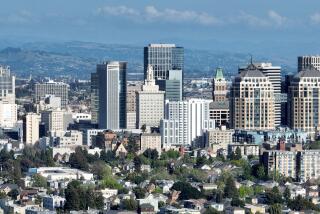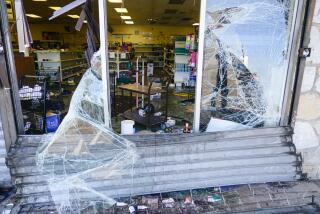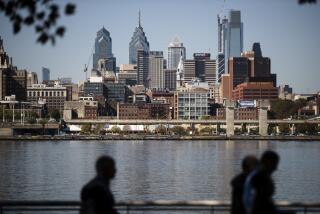With 10 p.m. curfew enforced, Baltimore sees a calmer night
- Share via
Reporting from Baltimore — With the National Guard on patrol and the city under curfew, officials struggled Tuesday to prevent a second night of rioting and appeared to succeed.
Baltimore Police Commissioner Anthony Batts said at a late-night news conference that 10 people had been arrested: two for looting, one for disorderly conduct and seven for violating the 10 p.m. curfew. “The city is stable,” he said.
The night before, more than 200 people were arrested after unrest that followed the funeral of a young black man whose spine was nearly severed in police custody. The riots drew rebukes from the mayor, residents and President Obama.
As darkness blanketed the city Tuesday, helicopters thundered above crowds defying the curfew, and officials used loudspeakers to urge people to get off the streets. Some defiant protesters were met with pepper spray from riot police, who stood in long lines hoisting shields for protection.
Community leaders joined officers in appealing for stragglers to go home and prevent another round of looting, arson and rock-throwing.
“Please go home to your families. I’m not asking you, I’m begging you,” Rep. Elijah E. Cummings (D-Md.), whose district includes much of Baltimore, told a crowd lingering outside a looted CVS pharmacy on the city’s west side, the center of Monday’s violence.
Darien Ford, 25, said that standing their ground was how demonstrators’ voices could be heard. “It looks like this is the only way to get some attention here in Baltimore,” he said.
Nevertheless, the crowds soon thinned.
Baltimore, a city of 622,000, had erupted in anger after the funeral of Freddie Gray, 25, whose death is the latest in a string of incidents to fuel allegations of police abuse of minority men. Gray died April 19, a week after his injury. Six officers have been suspended with pay during the investigation into the incident.
The toll from Monday’s violence was staggering. More than 235 people were arrested, including at least 34 juveniles; 15 buildings were set on fire; 144 vehicles were destroyed; about 20 police officers were injured, including one who was hit in the head with an object and remained hospitalized Tuesday, Batts said. At least one civilian was in critical condition as a result of a building fire, police said.
Public schools closed Tuesday, keeping nearly 85,000 children out of classes. Schools were to reopen Wednesday.
The American Heart Assn. canceled a medical conference in Baltimore this week.
The Baltimore Orioles postponed until May home games against the Chicago White Sox that had been scheduled for Monday and Tuesday. But in a first for Major League Baseball, the Orioles’ game Wednesday against Chicago was to be closed to the public and played in an empty stadium.
At the White House, Obama said Gray’s death was part of a “slow-rolling crisis” afflicting America.
“We have seen too many instances of what appears to be police officers interacting with individuals — primarily African American, often poor — in ways that have raised troubling questions. And it comes up, it seems like, once a week now, or once every couple of weeks,” he said. “And so I think it’s pretty understandable why the leaders of civil rights organizations, but more importantly moms and dads across the country, might start saying this is a crisis.”
Obama also denounced “criminals and thugs” who he said hijacked what had been peaceful demonstrations. “When individuals get crowbars and start prying open doors to loot, they’re not protesting, they’re not making a statement — they’re stealing,” he said. “When they burn down a building, they’re committing arson.”
The president said the nation needed to attack the root causes of discontent, including poverty, shortcomings in early education and a criminal justice system that renders people unemployable after felony convictions on nonviolent drug offenses.
Residents of the afflicted Baltimore neighborhoods were distraught over the damage. Their city had not seen such violence since race riots in 1968 triggered by the assassination of the Rev. Martin Luther King Jr.
Tears streamed from behind Rudae Kenly’s dark sunglasses as she looked at North Avenue, its shops marked by broken windows and barren shelves. “I have love for my city, but I can’t support what’s happening here,” said Kenly, 32, a veterinarian technician. “This is my hometown. I’ve been here my whole life. Seeing this breaks my heart.”
“There’s just no excuse for this,” said Earl Johnson, a resident who pleaded unsuccessfully with looters not to attack a Rite Aid drugstore in his east-side neighborhood Monday night. “Think about the absurdity of trashing your own neighborhood to make a point. It doesn’t make any sense.”
Parts of Baltimore resembled a city under military occupation, with National Guard troops in camouflage guarding key intersections and strategic infrastructure, including City Hall. Occasionally, a phalanx of Humvees carrying troops raced down avenues, accompanied by police cars with sirens screaming.
The Mondawmin Mall, where the riots began, was a scene of shattered glass and desolation. A day earlier, waves of mostly teenage boys and young men had ransacked shops and carted away gym shoes, clothes and expensive video game consoles.
Police defended their response, saying they had to show restraint because of the ages of many of those involved. Batts and Police Capt. Eric Kowalczyk said the looting began after teenagers swarmed over the mall in response to social media calls for a “purge” at 3 p.m. Monday. Such calls have circulated before and are based on the film “The Purge,” which posits a dystopia where all laws are suspended for 12 hours.
“Do you want people using force on 14-, 15-, 16-year-old kids?” Batts said. “They’re old enough to know better … but they’re still kids. And so we had to take that into account.”
Some parts of Baltimore tried to return to a semblance of normality. Volunteers bringing brooms and shovels from their homes showed up in droves Tuesday to clean up riot debris. Many offered bottled water to police who stood guard over damaged shops.
But there was a fear that the goodwill could sour at any time.
“The anger you saw is about decades of pain and abuse in our community,” said Megan Kenny, 38, as she joined others in cleaning up North Avenue. “The movement isn’t going to end. I mean, how do you end racism?”
Bierman and Hennigan reported from Baltimore and Susman from New York. Times staff writers Joseph Tanfani in Baltimore and Michael A. Memoli and Christi Parsons in Washington contributed to this report.
More to Read
Sign up for Essential California
The most important California stories and recommendations in your inbox every morning.
You may occasionally receive promotional content from the Los Angeles Times.













